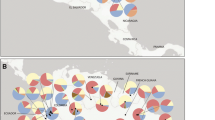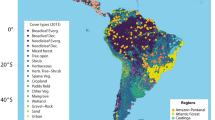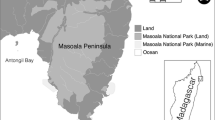Abstract
Hunting is one of the greatest threats to nonhuman primates worldwide. Despite Madagascar’s status as a primate mega-diversity country, a critical lack of information on the hunting of lemurs at the national scale persists. Here, we synthesize the current state of knowledge of the annual rates of household-level lemur hunting near ten protected areas, representing most ecoregions in Madagascar. We examine geographic and taxonomic variation in lemur hunting, including an analysis of hunting relative to species density, extinction risk, and intrinsic ecological characteristics of species. We found that lemurs are commonly hunted across Madagascar; the rural households in our study ate, on average, more than one lemur each year, or a median of 4.1% of the lemur species’ population size where densities are known. However, this pressure varied significantly across sites and species, reaching its highest levels in the northeastern rainforest region. While hunting levels are concerning for numerous threatened species, hunting pressure was driven primarily by species availability, and among ecological traits, small body size was related to increased hunting; however, conservation status showed no such relationship. This first national-level assessment of hunting, including one-third of Madagascar’s lemur species and more than a tenth of the world’s primates, identifies regional variation and lemur taxa at acute risk from hunting—important steps toward developing targeted strategies to conserve one of the world’s most threatened groups of vertebrates.



Similar content being viewed by others
References
Bachmann, M. E., Junker, J., Mundry, R., Nielsen, M. R., Haase, D., et al. (2019). Disentangling economic, cultural, and nutritional motives to identify entry points for regulating a wildlife commodity chain. Biological Conservation, 238, 108177. https://doi.org/10.1016/j.biocon.2019.07.022.
Bachmann, M. E., Nielsen, M. R., Cohen, H., Haase, D., Kouassi, J. A. K., et al (2020). Saving rodents, losing primates: Why we need tailored bushmeat management strategies. People and Nature, 2, 889–902. https://doi.org/10.1002/pan3.10119.
Baden, A. L., Mancini, A. N., Federman, S., Holmes, S. M., Johnson, S. E., et al (2019). Anthropogenic pressures drive population genetic structuring across a Critically Endangered lemur species range. Scientific Reports, 9(1), 16276. https://doi.org/10.1038/s41598-019-52689-2.
Bartoń, K. (2020). MuMIn: Multi-model inference. R package version, 1(43), 17 https://CRAN.R-project.org/package=MuMIn.
Bates, D., Mächler, M., Bolker, B., & Walker, S. (2015). Fitting linear mixed-effects models using lme4., 67(1), Journal of Statistical Software, 1–Journal of Statistical Softwa48. https://doi.org/10.18637/jss.v067.i01.
Booth, H., Clark, M., Milner-Gulland, E.J., Amponsah-Mensah, K., Antunes, A.P., et al (2021). Investigating the risks of removing wild meat from global food systems. Current Biology. https://doi.org/10.1016/j.cub.2021.01.079.
Borgerson, C. (2015). The effects of illegal hunting and habitat on two sympatric endangered primates. International Journal of Primatology, 36(1), 74–93. https://doi.org/10.1007/s10764-015-9812-x.
Borgerson, C. (2016). Optimizing conservation policy: The importance of seasonal variation in hunting and meat consumption on the Masoala peninsula of Madagascar. Oryx, 50(3), 405–418. https://doi.org/10.1017/S0030605315000307.
Borgerson, C., Johnson, S. E., Louis, E. E., Holmes, S. M., Anjaranirina, E. J. G., et al (2018b). The use of natural resources to improve income, health, and nutrition within the forests of Kianjavato, Madagascar. Madagascar Conservation & Development, 13(1), 45–52. https://doi.org/10.4314/mcd.v13i1.6.
Borgerson, C., McKean, M. A., Sutherland, M. R., & Godfrey, L. R. (2016). Who hunts lemurs and why they hunt them. Biological Conservation, 197, 124–130. https://doi.org/10.1016/S0006320716300556.
Borgerson, C., Razafindrapaoly, B., Rajoana, D., Rasolofoniaina, B. J. R., & Golden, C. D. (2019a). Food insecurity and the unsustainable hunting of wildlife in a UNESCO World Heritage site. Frontiers in Sustainable Food Systems: Land, Livelihoods, and Food Security, 3, 99. https://doi.org/10.3389/fsufs.2019.00099.
Borgerson, C., Randrianasolo, J. F., Andraina, T. R., Anjaranirina, E. J. G., Randriamady, H. J., et al (2019b). Wildlife hunting in complex human-environmental systems: How understanding natural resource use and human welfare can improve conservation in the Ankarafantsika National Park, Madagascar. Madagascar Conservation & Development, 14(1), 37–45. https://doi.org/10.4314/mcd.v14i1.7.
Borgerson, C., Vonona, M. A., Vonona, T., Anjaranirina, E. J. G., Lewis, R., et al (2018a). An evaluation of the interactions among household economies, human health, and wildlife hunting in the Lac Alaotra wetland complex of Madagascar. Madagascar Conservation & Development, 13(1), 25–33. https://doi.org/10.4314/mcd.v13i1.5.
Brook, C. E., Herrera, J., Borgerson, C., Fuller, E., Andriamahazoarivosoa, P., et al (2019). Population viability and bushmeat harvest sustainability for Madagascar lemurs. Conservation Biology, 33(1), 99–111. https://doi.org/10.1111/cobi.13151.
Buckland, S. T. (2001). Introduction to distance sampling: Estimating abundance of biological populations. London: Oxford University Press.
Buckland, S. T., Anderson, D. R., Burnham, K. P, & Laake, J. L. (1993). Distance sampling: Estimating abundance of biological populations. London: Chapman and Hall.
Burnham, K. P., & Anderson, D. R. (2002). Model selection and multimodel inference: A practical information-theoretic approach (2nd ed.). New York: Springer Science+Business Media.
Carbone, C., Cowlishaw, G., Isaac, N. J. B., Rowcliffe, J. M., & Raymond, B. H. (2005). How far do animals go? Determinants of day range in mammals. The American Naturalist, 165(2), 290–297. https://doi.org/10.1086/426790.
Chaves, L. S., Alves, R. R. N., & Albuquerque, U. P. (2020). Hunters’ preferences and perceptions as hunting predictors in a semiarid ecosystem. Science of the Total Environment, 726, 138494. https://doi.org/10.1016/j.scitotenv.2020.138494.
de Araujo Lima Constantino, P., Valente-Neto, F., Nunes, A. V., & Campos-Silva, J. V. (2021). Culture still matters: Conservation implications of hunting by ethnolinguistic groups in Southwestern Amazonia after centuries of contact. Biodiversity Conservation. https://doi.org/10.1007/s10531-020-02099-y.
Direction du Système des Aires Protégées. (2017). Shapefiles of the protected areas of Madagascar.
Dunn, M. A., & Smith, D. A. (2011). The Spatial Patterns of Miskitu Hunting in Northeastern Honduras: Lessons for Wildlife Management in Tropical Forests. Journal of Latin American Geography, 10(1), 85–108.
Duporge, I., Hodgetts, T., Wang, T., & Macdonald, D. W. (2020). The spatial distribution of illegal hunting of terrestrial mammals in sub-Saharan Africa: A systematic map. Environmental Evidence, 9(1), 15. https://doi.org/10.1186/s13750-020-00195-8.
Effiom, E. O., Nuñez-Iturri, G., Smith, H. G., Ottosson, U., & Olsson, O. (2013). Bushmeat hunting changes regeneration of African rainforests. Proceedings of the Royal Society B: Biological Sciences, 280(1759). https://doi.org/10.1098/rspb.2013.0246.
Estrada, A., Garber, P. A., Mittermeiee, R. A., Wich, S., Gouveia, S., et al (2018). Primates in peril: The significance of Brazil, Madagascar, Indonesia and the Democratic Republic of the Congo for global primate conservation. PeerJ, 6. https://doi.org/10.7717/peerj.4869.
Estrada, A., Garber, P. A., Rylands, A. B., Roos, C., Fernandez-Duque, E., et al (2017). Impending extinction crisis of the world’s primates: Why primates matter. Science Advances, 3(1). https://doi.org/10.1126/sciadv.1600946.
Fa, J. E., Ryan, S. F., & Bell, D. J. (2005). Hunting vulnerability, ecological characteristics and harvest rate of bushmeat species in afrotropical forests. Biological Conservation, 121(2), 167–176. https://doi.org/10.1016/j.biocon.2004.04.016.
Ganzhorn, J. U., Fietz, J., Rakotovao, E., Schwab, D., & Zinner, D. (1999). Lemurs and the regeneration of dry deciduous forest in Madagascar. Conservation Biology, 13, 794–804. https://doi.org/10.1046/j.1523-1739.1999.98245.x.
Gardner, C. J., Bicknell, J. E., Baldwin-Cantello, W., Struebig, M. J., & Davies, Z. G. (2019). Quantifying the impacts of defaunation on natural forest regeneration in a global meta-analysis. Nature Communications, 10(1), 4590. https://doi.org/10.1038/s41467-019-12539-1.
Gaynor, K. M., Hojnowski, C. E., Carter, N. H., & Brashares, J. S. (2018). The influence of human disturbance on wildlife nocturnality. Science, 360(6394), 1232–1235. https://doi.org/10.1126/science.aar7121.
Global Forest Watch. (2019). World Resources Institute. www.globalforestwatch.org (accessed August 1, 2020).
Godfrey, L. R., & Irwin, M. T. (2007). The evolution of extinction risk: Past and present anthropogenic impacts on the primate communities of Madagascar. Folia Primatologica, 78(5–6), 405–419. https://doi.org/10.1159/000105152.
Godfrey, L. R., Scroxton, N., Crowley, B. E., Burns, S. J., Sutherland, M. R., et al (2019). A new interpretation of Madagascar's megafaunal decline: The “subsistence shift hypothesis”. Journal of Human Evolution, 130, 126–140. https://doi.org/10.1016/j.jhevol.2019.03.002.
Golden, C. D. (2009). Bushmeat hunting and use in the Makira Forest, north-eastern Madagascar: A conservation and livelihoods issue. Oryx, 43(3), 386–392. https://doi.org/10.1017/S0030605309000131.
Golden, C. D., Bonds, M. H., Brashares, J. S., Rasolofoniaina, B. J. R., & Kremen, C. (2014a). Economic valuation of subsistence harvest of wildlife in Madagascar. Conservation Biology, 28, 234–243. https://doi.org/10.1111/cobi.12174.
Golden, C. D., Desisto, C., Borgerson, C., & Randriamady, H. J. (2022, in press). Hunting and the consumption of wildlife on Madagascar. In S. M. Goodman (Ed.), The new natural history of Madagascar. Princeton, NJ: Princeton University Press.
Golden, C. D., Fernald, L. C. H., Brashares, J. S., Rasolofoniaina, B. J. R., & Kremen, C. (2011). Benefits of wildlife consumption to child nutrition in a biodiversity hotspot. Proceedings of the National Academy of Sciences of the USA, 108, 19653–19656. https://doi.org/10.1073/pnas.1112586108.
Golden, C. D., Rabehatonina, J. G. C., Rakotosoa, A., & Moore, M. (2014b). Socio-ecological analysis of natural resource use in Betampona Strict Natural Reserve. Madagascar Conservation & Development, 9, 83–89. https://doi.org/10.4314/mcd.v9i2.4.
Golden, C. D., Vaitla, B., Ravaoliny, L., Vonona, M. A., Anjaranirina, E. G., et al (2019). Seasonal trends of nutrient intake in rainforest communities of north-eastern Madagascar. Public Health Nutrition, 22(12), 2200–2209. https://doi.org/10.1017/S1368980019001083.
Golden, C. D., Wrangham, R. W., & Brashares, J. S. (2013). Recall accuracy for wildlife consumption. Animal Conservation, 16, 597–603. https://doi.org/10.1111/acv.12047.
Goodman, S. M., Raherilalao, M. J., & Wohlhauser, S. (2018). The terrestrial protected areas of Madagascar: Their history, description, and biota. Antananarivo Madagascar: Association Vahatra.
Hall, R. J., Milner-Gulland, E. J., & Courchamp, F. (2008). Endangering the endangered: The effects of perceived rarity on species exploitation. Conservation Letters, 1(2), 75–81. https://doi.org/10.1111/j.1755-263X.2008.00013.x.
Hansford, J., Wright, P. C., Rasoamiaramanana, A., Pérez, V. R., Godfrey, L. R., et al (2018). Early Holocene human presence in Madagascar evidenced by exploitation of avian megafauna. Science Advances, 4(9), eaat6925. https://doi.org/10.1126/sciadv.aat6925.
Harrison, X. A., Donaldson, L., Correa-Cano, M. E., Evans, J., Fisher, D. N., et al (2018). A brief introduction to mixed effects modelling and multi-model inference in ecology. PeerJ, 6, e4794. https://doi.org/10.7717/peerj.4794.
Isaac, N. J. B., & Cowlishaw, G. (2004). How species respond to multiple extinction threats. Proceedings of the Royal Society Series B: Biological Sciences, 271, 1135–1141. https://doi.org/10.1098/rspb.2004.2724.
IUCN. (2020). The IUCN Red List of Threatened Species. www.iucnredlist.org (accessed August 18, 2020).
Jenkins, R. K., Keane, A., Rakotoarivelo, A. R., Rakotomboavonjy, V., Randrianandrianina, F. H., et al (2011). Analysis of patterns of bushmeat consumption reveals extensive exploitation of protected species in eastern Madagascar. PLoS ONE, 6(12), e27570. https://doi.org/10.1371/journal.pone.0027570.
Jerozolimski, A., & Peres, C. A. (2003). Bringing home the biggest bacon: a cross-site analysis of the structure of hunter-kill profiles in Neotropical forests. Biological Conservation, 111(3), 415–425.
Koster, J. M., Hodgen, J. J., Venegas, M. D., & Copeland, T. J. (2010). Is meat flavor a factor in hunters’ prey choice decisions? Human Nature, 21(3), 219–242. https://doi.org/10.1007/s12110-010-9093-1.
Kumpel, N. F., Milner-Gulland, E. J., Cowlishaw, G., & Rowcliffe, J. M. (2010). Assessing sustainability at multiple scales in a rotational bushmeat hunting system. Conservation Biology, 24(3), 861–871. https://doi.org/10.1111/j.1523-1739.2010.01505.x.
Kutner, M. H., Nachtsheim, C. J., & Neter, J. (2004). Applied linear regression models, 4th ed. (pp. 495, 497). McGraw-Hill Irwin.,
Lloyd, C. (2016). WorldPop Archive global gridded spatial datasets. Version Alpha 0.9. Harvard Dataverse (Dataset). https://dataverse.harvard.edu/dataverse/WorldPop (accessed July 1, 2020).
Lloyd, C., Sorichetta, A., & Tatem, A. (2017). High resolution global gridded data for use in population studies. Scientific Data, 4, 170001. https://doi.org/10.1038/sdata.2017.1.
Martin, A., Caro, T., & Kiffner, C. (2013). Prey preferences of bushmeat hunters in an east African savannah ecosystem. European Journal of Wildlife Research, 59, 137–145. https://doi.org/10.1007/s10344-012-0657-8.
Martins, V., & Shackleton, C. M. (2019). Bushmeat use is widespread but under-researched in rural communities of South Africa. Global Ecology and Conservation, 17, e00583. https://doi.org/10.1016/j.gecco.2019.e00583.
McDonald, T., Carlisle, J., McDonald, A., Nielson, R., Augustine, B., et al (2019). https://cran.r-project.org/web/packages/Rdistance/index.html.
Merson, S. D., Dollar, L. J., Johnson, P. J., & Macdonald, D. W. (2019). Poverty not taste drives the consumption of protected species in Madagascar. Biodiversity Conservation, 28, 3669–3689. https://doi.org/10.1007/s10531-019-01843-3.
Milton, K., & May, M. L. (1976). Body weight, diet and home range area in primates. Nature, 259(5543), 459–462. https://doi.org/10.1038/259459a0.
Mittermeier, R. A., Louis, J. E. E., Richardson, M., Schwitzer, C., Langrand, O., et al (2010). Lemurs of Madagascar (3rd ed.). Arlington, VA: Conservation International.
Noromiarilanto, F., Brinkmann, K., Faramalala, M. H., & Buerkert, A. (2016). Assessment of food self-sufficiency in smallholder farming systems of south-western Madagascar using survey and remote sensing data. Agricultural Systems, 149, 139–149. https://doi.org/10.1016/j.agsy.2016.09.005.
Peres, C. A., Emilio, T., Schietti, J., Desmouliere, S. J. M., & Levi, T. (2016). Dispersal limitation induces long-term biomass collapse in overhunted Amazonian forests. Proceedings of the National Academy of Sciences of the USA, 113(4), 892–897. https://doi.org/10.1073/pnas.1516525113.
Perez, V. R., Godfrey, L. R., Nowak-Kemp, M., Burney, D. A., Ratsimbazafy, J., & Vasey, N. (2005). Evidence of early butchery of giant lemurs in Madagascar. Journal of Human Evolution, 49(6), 722–742. https://doi.org/10.1016/j.jhevol.2005.08.004.
Poelstra, J., Salmona, J., Tiley, G. P., Schüßler, D., Blanco, M. B., et al (2020). Cryptic patterns of speciation in cryptic primates: microendemic mouse lemurs and the multispecies coalescent. Systematic Biology, 70(2), 203–218. https://doi.org/10.1093/sysbio/syaa053.
Rakotondrafara, M. L., Randriamarolaza, L. Y. A., Rasolonjatovo, H., Rakotomalala, & C. L. Razanakakiniana. (2018). In S. M. Goodman, M. J. Raherilalao, & S. Wohlhauser (Eds.), The terrestrial protected areas of Madagascar: Their history, description, and biota (pp.199–206). Antananarivo Madagascar: Association Vahatra.
Razafimanahaka, J. H., Jenkins, R. K. B., Andriafidison, D., Randrianandrianina, F., Rakotomboavonjy, V., et al (2012). Novel approach for quantifying illegal bushmeat consumption reveals high consumption of protected species in Madagascar. Oryx, 46(4), 584–592. https://doi.org/10.1017/S0030605312000579.
Razafindratsima, O. H., & Dunham, A. E. (2014). Assessing the impacts of nonrandom seed dispersal by multiple frugivore partners on plant recruitment. Ecology, 96(1), 24–30. https://doi.org/10.1890/14-0684.1.
Razafindratsima, O. H., Yacoby, Y., & Park, D. S. (2018). MADA: Malagasy animal trait data archive. Ecology, 99(4), 990–990. https://doi.org/10.1002/ecy.2167.
Razafindratsima, O. H., Gentles, A., Drager, A. P., Razafimahaimodison, J.-C. A., Ralazampirenena, C. J., & Dunham, A. E. (2018). Consequences of lemur loss for above-ground carbon stocks in a Malagasy rainforest. International Journal of Primatology, 39(3), 415–426. https://doi.org/10.1007/s10764-018-0042-x.
Reuter, K. E., Blanco, M., Ganzhorn, J. & Schwitzer, C. (2020). Microcebus murinus. The IUCN Red List of Threatened Species 2020: e.T163314248A115567306. 10.2305/IUCN.UK.2020–2.RLTS.T163314248A115567306.en (accessed August 2020).
Reuter, K. E., Randell, H., Wills, A. R., & Sewall, B. J. (2016). The consumption of wild meat in Madagascar: Drivers, popularity and food security. Environmental Conservation, 43(3), 273–283. https://doi.org/10.1017/S0376892916000059.
Rice, B. L., Annapragada, A. V., Baker, R. E., Bruijning, M., Dotse-Gborgbortsi, W., et al (2020). High variation expected in the pace and burden of SARS-CoV-2 outbreaks across sub-Saharan Africa. medRxiv. https://doi.org/10.1101/2020.07.23.20161208.
Richard, A. F., Dewar, R. E., Schwartz, M., & Ratsirarson, J. (2002). Life in the slow lane? Demography and life histories of male and female sifaka (Propithecus verreauxi verreauxi). Journal of Zoology, 256, 421–436. https://doi.org/10.1017/S0952836902000468.
Ripple, W. J., Abernethy, K., Betts, M. G., Chapron, G., Dirzo, R., et al (2016). Bushmeat hunting and extinction risk to the world's mammals. Royal Society Open Science, 3(10), 160498. https://doi.org/10.1098/rsos.160498.
Rowe, N., & Myers, M. (2016). All the world’s primates. Charlestown, RI: Pogonias Press.
Schüßler, D., Blanco, M. B., Salmona, J., Poelstra, J., Andriambeloson, J. B., et al (2020). Ecology and morphology of mouse lemurs (Microcebus spp.) in a hotspot of microendemism in northeastern Madagascar, with the description of a new species. American Journal of Primatology, e23180. https://doi.org/10.1002/ajp.23180.
Schwitzer, C., Mittermeier, R. A., Davies, N., Johnson, S., Ratsimbazafy, J., et al (Eds.). (2013). Lemurs of Madagascar: A strategy for their conservation 2013–2016. Bristol: IUCN SSC Primate Specialist Group, Bristol Conservation and Science Foundation, and Conservation International.
Schwitzer, C., Mittermeier, R. A., Johnson, S. E., Donati, G., Irwin, M., et al (2014). Averting lemur extinctions amid Madagascar's political crisis. Science, 343, 842–843. https://doi.org/10.1126/science.1245783.
Sirén, A. H., & Wilkie, D. S. (2016). The effects of ammunition price on subsistence hunting in an Amazonian village. Oryx, 50, 47–55. https://doi.org/10.1017/S003060531400026X.
Smith, D. A. (2005). Garden game: Shifting cultivation, indigenous hunting and wildlife ecology in western Panama. Human Ecology, 33, 505–537. https://doi.org/10.1007/s10745-005-5157-Y.
Smith, M. (2016). Nutrient Supplies by Food and Country (2011). Harvard Dataverse, V3. https://doi.org/10.7910/DVN/UZW5S3.
Stafford, C. A., Preziosi, R. F., & Sellers, W. I. (2017). A pan-neotropical analysis of hunting preferences. Biodiversity Conservation, 26, 1877–1897. https://doi.org/10.1007/s10531-017-1334-8.
UNEP-WCMC, & IUCN. (2020). Protected planet. The world database on protected areas (WDPA)/the global database on protected areas management effectiveness (GD-PAME). July 2020, Cambridge, UK: UNEP-WCMC and IUCN. www.protectedplanet.net (accessed July, 2020).
van Vliet, N. (2018). “Bushmeat crisis” and “cultural imperialism” in wildlife management? Taking value orientations into account for a more sustainable and culturally acceptable wildmeat sector. Frontiers in Ecology and Evolution, 6, 1–6. https://doi.org/10.3389/fevo.2018.00112.
van Vliet, N., & Mbazza, P. (2011). Recognizing the multiple reasons for bushmeat consumption in urban areas: A necessary step toward the sustainable use of wildlife for food in central Africa. Human Dimensions of Wildlife, 16, 45–54. https://doi.org/10.1080/10871209.2010.523924.
van Velden, J., Wilson, K., & Biggs, D. (2018). The evidence for the bushmeat crisis in African savannas: A systematic quantitative literature review. Biological Conservation, 221, 345–356. https://doi.org/10.1016/j.biocon.2018.03.022.
Zuur, A., Ieno, E. N., Walker, N., Saveliev, A. A., & Smith, G. M. (2009). Mixed effects models and extensions in ecology with R. New York: Springer Science+Business Media.
Acknowledgments
We would like to extend our deepest gratitude to the communities in which we work. Without them, this research would have been impossible. We would also like to thank the editor, Joanna M. Setchell; the organizers of this special issue, Alejandro Estrada and Paul Garber, and two anonymous reviewers; Steven M. Goodman for kindly providing protected area shapefiles; Marina B. Blanco for her expert advice on taxonomy; Richard J. Bankoff for his support in estimating densities within Rdistance; and the Republic of Madagascar and Madagascar National Parks for their continued support and permission to conduct research. This research was funded by grants from the National Geographic Society Conservation Trust (C135–08, C280–14, C021–17, and 55616C-20), the Margot Marsh Biodiversity Foundation, Primate Action Fund, the National Science Foundation SBE-IBSS Postdoctoral Research Fellowship (1513638), the National Science Foundation Graduate Research Fellowship Program (2015213765), the Natural Sciences and Engineering Research Council of Canada, Global Wildlife Conservation, Lemur Conservation Action Fund (5095.005-0175), Primate Conservation Inc, Rowe Wright Grant (46), and International Union for the Conservation of Nature, Save our Species (IUCN-SOS 2018A-117).
Author information
Authors and Affiliations
Corresponding author
Additional information
Handling Editor: Alejandro Estrada
Supplementary Information
ESM 1
(DOCX 23 kb)
Rights and permissions
About this article
Cite this article
Borgerson, C., Johnson, S.E., Hall, E. et al. A National-Level Assessment of Lemur Hunting Pressure in Madagascar. Int J Primatol 43, 92–113 (2022). https://doi.org/10.1007/s10764-021-00215-5
Received:
Accepted:
Published:
Issue Date:
DOI: https://doi.org/10.1007/s10764-021-00215-5




